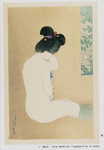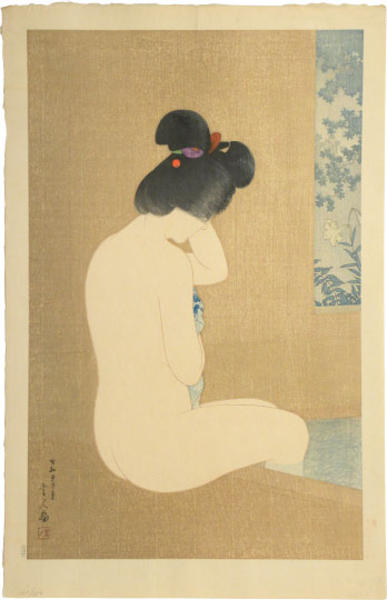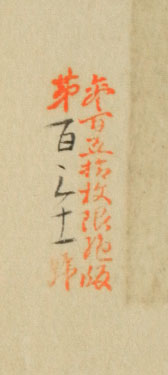| | |
| Artist: | Torii Kotondo (1900-1976) — 鳥居言人 |
| Title: | Fragrance of the Hot Spring — 湯の香 |
| Series: | |
| Date of first edition?: | 1930 |
| Date of this artwork?: | 1930 summer (may not be accurate) |
| Publisher (first edition)?: | Kawaguchi — 川口 |
| Publisher (this edition)?: | Kawaguchi — 川口 |
| Medium (first edition): | Woodblock |
| Medium (this edition): | Woodblock |
| Format (first edition): | Large Oban
|
| Format (this edition): | Large Oban |
| DB artwork code: | 45128 |
| Notes (first edition)?: |
| Torii Kotondo (1900-1976), Fragrance of the Hot Springs. Dated Summer 1930. Published only via Kawaguchi in an edition of 350. Rare. |
|
| Notes (this edition)?: |
| The following information was taken from the original web listing of this artwork. Note that there may be some inaccuracies:
Torii Kotondo, 1900-1976
Fragrance of the Hot Springs
(Yu no ka)
Dated and signed Showa gonen natsu (Showa 5 [1930], summer) Kotondo ga, with artist's seal Kotondo, publisher's oval seal Kawaguchi, and stamped in English on verso KAWAGUCHI, with limited edition seal stamped in red ink and hand-numbered in sumi ink, San hyaku-goju mai kagiri zeppan, dai hyaku-sanju-ichi, go (350 limited edition, number 131), ca. 1930.
Dai oban tate-e 18 by 11 5/8 in., 45.7 by 29.6 cm
References:
Kato, Junzo, comp., Kindai Nihon hanga taikei, 1975-76, Vol. III, pl. 114
Gallery Beniya, Torii Kotondo, 1995, p. 23, no. 14
Reigle Newland, Amy, and Hamanaka Shinji, The Female Image: 20th century prints of Japanese beauties, 2000, p.130, pl. 175 |
|
| Artist Bio: |
| Torii Kotondo (or Torii Kiyotada VIII) is renowned for his paintings and shin hanga prints of beautiful women. His woodblock prints, superbly carved and printed, are comparable with those of Hashiguchi Goyo and Ito Shinsui. Kotondo was born with the name Saito Akira in the Nihonbashi district of Tokyo. He was the only son among the five children of Torii Kiyotada, the seventh Torii master. The Torii school had a long tradition of painting and printmaking for the Japanese theater, extending back to the seventeenth century. Kabuki theater was still very popular in the early twentieth century and prints and painted posters were the primary means of publicity. Although Kotondo was mainly interested in studying history and archaeology, it was assumed that he would follow in his father's footsteps and join the Torii school. At age 14, Kotondo agreed to leave school and begin studies with Kobori Tomone, a yamato-e painter. Along with painting classes, Tomone taught Kotondo about the court and military practices of ancient Japan, satisfying his interest in history. A year later, he was officially adopted as the next heir of the Torii school and assumed the artist's name 'Kotondo'. While still studying with Tomone, he began designing illustrations for a theatrical magazine, Engei Gaho ('Entertainment Illustrated Magazine'), and painted kabuki posters and billboards. Torii Kotondo was the 8th Torii and the 5th Torii Kiyotada. His father was the 4th Kiyotada.
|
|








